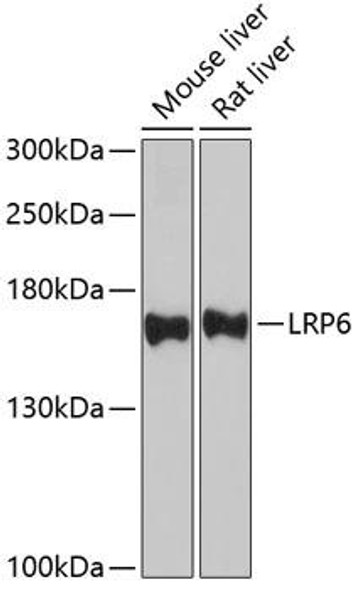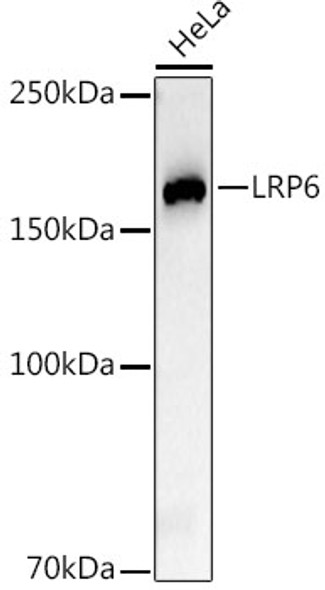Description
| Product Name: | Phospho-LRP6-S1490 Rabbit pAb |
| Product Code: | CABP1191 |
| Size: | 50uL, 100uL |
| Synonyms: | LRP6, ADCAD2, STHAG7 |
| Applications: | WB |
| Reactivity: | Human |
| Host Species: | Rabbit |
| Immunogen: | A synthetic phosphorylated peptide around S1490 of human LRP6. |
| Applications: | WB |
| Recommended Dilutions: | WB 1:500 - 1:2000 |
| Reactivity: | Human |
| Positive Samples: | HeLa |
| Immunogen: | A synthetic phosphorylated peptide around S1490 of human LRP6. |
| Purification Method: | Affinity purification |
| Storage: | Store at -20°C. Avoid freeze / thaw cycles. Buffer: PBS with 0.02% sodium azide, 50% glycerol, pH7.3. |
| Isotype: | IgG |
| Sequence: | Email for sequence |
| Gene ID: | 4040 |
| Uniprot: | O75581 |
| Cellular Location: | Endoplasmic reticulum, Membrane, Single-pass type I membrane protein |
| Calculated MW: | 180kDa |
| Observed MW: | 180KDa |
| UniProt Protein Function: | LRP6: Component of the Wnt-Fzd-LRP5-LRP6 complex that triggers beta-catenin signaling through inducing aggregation of receptor- ligand complexes into ribosome-sized signalsomes. Cell-surface coreceptor of Wnt/beta-catenin signaling, which plays a pivotal role in bone formation. The Wnt-induced Fzd/LRP6 coreceptor complex recruits DVL1 polymers to the plasma membrane which, in turn, recruits the AXIN1/GSK3B-complex to the cell surface promoting the formation of signalsomes and inhibiting AXIN1/GSK3- mediated phosphorylation and destruction of beta-catenin. Required for posterior patterning of the epiblast during gastrulation. Homodimer; disulfide-linked. Forms phosphorylated oligomer aggregates on Wnt-signaling. Forms a WNT-signaling complex formed of a WNT protein, a FZD protein and LRP5 or LRP6. Interacts (via the extracellular domain) with WNT1; the interaction is enhanced by prior formation of the Wnt/Fzd complex. Interacts (via the beta-propeller regions 3 and 4) with WNT3A. Interacts (via the beta-propeller regions 1 and 2) with WNT9B. Interacts with FZD5; the interaction forms a coreceptor complex for Wnt signaling and is inhibited by DKK1 and C1orf187. Interacts (via beta propeller region) with DKK1; the interaction inhibits FZD5/LRP6 complex formation. Interacts with DKK2. Interacts with C1orf187/DRAXIN; the interaction inhibits Wnt signaling. Interacts (via the phosphorylated PPPSP motifs) with AXIN1; the interaction recruits the AXIN1/GSK3B complex to cell surface LRP6 signalsomes. Interacts with GRB10; the interaction prevents AXIN1 binding, thus negatively regulating the Wnt signaling pathway. Interacts (via the extracellular domain) with RSPO1; the interaction activates Wnt/beta-catenin signaling. Interacts (via the extracellular domain) with RSPO3 (via the cysteine rich domain); the interaction activates Wnt/beta-catenin signaling. Interacts (via the beta- propeller regions 1 and 2) with SOST; the interaction competes with DKK1 for binding for inhibiting beta-catenin signaling. Interacts with MESD; the interaction prevents the formation of LRP6 aggregates and targets LRP6 to the plasma membrane. Interacts (via the cytoplasmic domain) with CSNKIE; the interaction phosphorylates LRP6, binds AXIN1 and inhibits AXIN1/GSK3B-mediated phosphorylation of beta-catenin. Interacts with MACF1. Decreased levels on WNT3A stimulation. Widely co-expressed with LRP5 during embryogenesis and in adult tissues. Belongs to the LDLR family. |
| UniProt Protein Details: | Protein type:Membrane protein, integral; Receptor, misc. Chromosomal Location of Human Ortholog: 12p13.2 Cellular Component: Golgi apparatus; cell surface; cell soma; early endosome membrane; endoplasmic reticulum; early endosome; extracellular region; integral to membrane; plasma membrane; synapse; cytoplasmic vesicle; caveola; receptor complex Molecular Function:low-density lipoprotein receptor activity; Wnt-protein binding; identical protein binding; protein binding; Wnt receptor activity; protein homodimerization activity; frizzled binding; kinase inhibitor activity; toxin transporter activity; apolipoprotein binding; receptor binding Biological Process: embryonic forelimb morphogenesis; response to peptide hormone stimulus; radial glial cell differentiation in the forebrain; positive regulation of apoptosis; regulation of fat cell differentiation; positive regulation of transcription, DNA-dependent; cerebellum morphogenesis; palate development; Wnt receptor signaling pathway through beta-catenin; thalamus development; embryonic pattern specification; bone remodeling; embryonic hindlimb morphogenesis; Wnt receptor signaling pathway in forebrain neuroblast division; anterior/posterior pattern formation; synaptic transmission; elevation of cytosolic calcium ion concentration; cell-cell adhesion; negative regulation of protein amino acid phosphorylation; response to folic acid; convergent extension; positive regulation of mesenchymal cell proliferation; midbrain development; positive regulation of bone resorption; heart looping; neural crest cell differentiation; cell migration involved in gastrulation; negative regulation of epithelial cell proliferation; embryonic limb morphogenesis; Wnt receptor signaling pathway; external genitalia morphogenesis; neural crest formation; positive regulation of cell cycle; gastrulation with mouth forming second; negative regulation of fat cell differentiation; positive regulation of ossification; odontogenesis of dentine-containing teeth; formation of radial glial scaffolds; cerebral cortex cell migration; embryonic retina morphogenesis in camera-type eye; midbrain-hindbrain boundary development; neural tube closure; negative regulation of protein kinase activity; positive regulation of transcription from RNA polymerase II promoter; positive regulation of transcription factor activity; embryonic digit morphogenesis; embryonic camera-type eye morphogenesis; cerebral cortex development; regulation of ossification Disease: Coronary Artery Disease, Autosomal Dominant 2 |
| NCBI Summary: | This gene encodes a member of the low density lipoprotein (LDL) receptor gene family. LDL receptors are transmembrane cell surface proteins involved in receptor-mediated endocytosis of lipoprotein and protein ligands. The protein encoded by this gene functions as a receptor or, with Frizzled, a co-receptor for Wnt and thereby transmits the canonical Wnt/beta-catenin signaling cascade. Through its interaction with the Wnt/beta-catenin signaling cascade this gene plays a role in the regulation of cell differentiation, proliferation, and migration and the development of many cancer types. This protein undergoes gamma-secretase dependent RIP- (regulated intramembrane proteolysis) processing but the precise locations of the cleavage sites have not been determined.[provided by RefSeq, Dec 2009] |
| UniProt Code: | O75581 |
| NCBI GenInfo Identifier: | 317373385 |
| NCBI Gene ID: | 4040 |
| NCBI Accession: | O75581.2 |
| UniProt Secondary Accession: | O75581,Q17RZ2, |
| UniProt Related Accession: | O75581 |
| Molecular Weight: | 1613 |
| NCBI Full Name: | Low-density lipoprotein receptor-related protein 6 |
| NCBI Synonym Full Names: | low density lipoprotein receptor-related protein 6 |
| NCBI Official Symbol: | LRP6 |
| NCBI Official Synonym Symbols: | ADCAD2 |
| NCBI Protein Information: | low-density lipoprotein receptor-related protein 6; LRP-6 |
| UniProt Protein Name: | Low-density lipoprotein receptor-related protein 6 |
| Protein Family: | Low-density lipoprotein receptor-related protein |
| UniProt Gene Name: | LRP6 |
| UniProt Entry Name: | LRP6_HUMAN |






